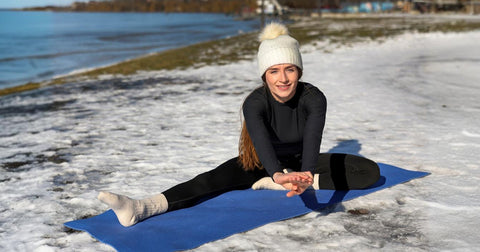As temperatures drop, many people experience a worsening of joint stiffness and discomfort. Cold weather can reduce circulation, tighten muscles, and exacerbate inflammation, making it harder to move comfortably.
Whether you suffer from arthritis or occasional joint pain, there are natural ways to maintain mobility and stay pain-free throughout the colder months. This post explores tips for joint health during cold weather, focusing on nutrition, supplements, and physical activity.
How Cold Weather Affects Joint Health
Cold temperatures can cause blood vessels to constrict, reducing circulation to muscles and joints. This leads to stiffness, especially in areas already prone to inflammation, like knees, hips, and hands. The decrease in activity during the colder months can further contribute to reduced mobility and increased discomfort in the joints. For those with arthritis or other joint-related conditions, cold weather often triggers more intense flare-ups.
Staying Active to Maintain Mobility
One of the most effective ways to combat joint stiffness is to keep moving. Exercise helps improve circulation, increases joint lubrication, and strengthens the muscles surrounding joints, providing better support. However, not all exercises are suitable during colder months, so it’s important to choose low-impact activities that minimize strain on the joints:
- Yoga and Stretching: Gentle stretching or practicing yoga increases flexibility, reduces stiffness, and enhances joint mobility. Focus on poses that stretch the hips, knees, and lower back.
- Swimming: If you have access to a heated pool, swimming is an excellent full-body workout that is easy on the joints.
- Walking: Walking is a simple, low-impact exercise that improves circulation and strengthens leg muscles. Bundle up in layers to stay warm while walking outdoors or use a treadmill if the weather is too cold.
-
Strength Training: Strengthening the muscles around your joints takes pressure off them. Focus on exercises that build leg and core strength, such as squats or leg presses, using light weights to avoid overloading your joints.
Anti-Inflammatory Foods for Joint Health
Inflammation is a key factor in joint pain, particularly in conditions like arthritis. Consuming an anti-inflammatory diet can help reduce symptoms and improve overall joint health. Incorporate these foods into your daily meals for pain relief and mobility support:
- Fatty Fish: Salmon, mackerel, and sardines are rich in omega-3 fatty acids, which have been shown to reduce inflammation in joints and improve mobility.
- Turmeric: This spice contains curcumin, a potent anti-inflammatory compound. You can add turmeric to soups, smoothies, or teas, or take it as a supplement.
- Ginger: Known for its anti-inflammatory properties, ginger can reduce joint pain and swelling. Try adding fresh ginger to tea or meals.
- Berries and Leafy Greens: Rich in antioxidants, berries like blueberries and strawberries help reduce inflammation. Leafy greens like spinach and kale provide vitamins and minerals that support joint health.
-
Nuts and Seeds: Walnuts, flaxseeds, and chia seeds contain omega-3s and antioxidants, which fight inflammation and protect joint tissues.
Supplements for Joint Health
In addition to dietary changes, certain supplements can help protect and nourish the joints, reducing pain and stiffness:
- Glucosamine and Chondroitin: These two compounds are essential for cartilage health. They help repair and maintain cartilage, reducing joint pain, particularly in those with osteoarthritis.
- Collagen: Collagen provides structure to your joints and skin. Studies show that taking collagen supplements may reduce joint pain and improve mobility.
- MSM (Methylsulfonylmethane): This organic sulfur compound has anti-inflammatory effects and can reduce joint pain, improving flexibility.
- Vitamin D: During the colder months, many people become deficient in Vitamin D due to reduced sunlight exposure. Vitamin D supports calcium absorption and bone health, reducing the risk of joint and bone pain.
-
Omega-3 Fatty Acids: If you're not consuming enough omega-3s through food, consider an omega-3 supplement (such as fish oil) to reduce inflammation and support joint lubrication.
Lifestyle Tips to Reduce Joint Stiffness
Small lifestyle changes can also help alleviate joint pain during the colder months:
- Stay Warm: Cold weather tightens muscles and joints, so dress in layers to keep your body warm, especially when going outdoors. Use heat therapy such as warm baths, heating pads, or a sauna to relax tight muscles and reduce stiffness.
- Stay Hydrated: Dehydration can make joint pain worse. Make sure to drink plenty of water throughout the day to stay hydrated and maintain joint lubrication.
- Use Proper Footwear: Wearing supportive shoes with proper cushioning helps reduce the impact on your joints while walking. Avoid wearing shoes with high heels or inadequate arch support.
- Maintain a Healthy Weight: Carrying excess weight puts additional pressure on your joints, particularly the hips, knees, and lower back. By maintaining a healthy weight, you can reduce strain and minimize joint discomfort.
Cold weather doesn’t have to mean more joint pain and stiffness. By staying active, eating anti-inflammatory foods, and incorporating supplements into your routine, you can protect your joints and maintain mobility throughout the winter.
Whether you’re dealing with arthritis or occasional joint discomfort, these strategies will help keep your joints healthy and pain-free even in the coldest months.



